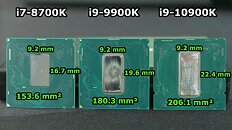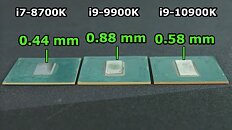Monday, May 25th 2020

Intel Core i9-10900K der8auer De-Lidding Reveals Accurate Die-Size Measurements
Professional overclocker and extreme cooling products developer der8auer de-lidded a Core i9-10900K 10-core processor to study the processor's behavior with various kinds of custom cooling setups. It was discovered that the 10-core "Comet Lake" die measures 206.1 mm² in die-area. It is 9.2 mm wide like its predecessors, "Coffee Lake" 8-core, 6-core, and 4-core, but is 22.4 mm long, with the outer edges of its packaging material barely within a couple of millimeters of the adhesion point of the integrated heatspreader (IHS). Given what we know about how much each pair of cores adds to these dies, we predict that Intel cannot elongate this die to 12 cores, without having to remove the iGPU. der8auer discovered that using liquid metal TIMs and running the processor de-lidded shaves up to 7 °C off temperatures. Find more technical commentary in the der8auer video presentation.
Source:
via Andreas Schilling (Twitter)


55 Comments on Intel Core i9-10900K der8auer De-Lidding Reveals Accurate Die-Size Measurements
Leave the iGPU for low power and mobile chips while the desktop processors are designed without an iGPU taking up precious die space.
1by2 cores measure 2.9mm,
so yes 4 cores wasted by the gpu.
you could make a 16 core by adding 6 cores to one side, removing the gpu, and center. but imagine cooling that 5.0Ghz 500 watt CPU.
The 8700K is about 40% IGP by area.
May have to wait until 2022 and 7nm Meteor Lake for the amazing thermal efficiency of the 8th gen to return once again. Oh well. :ohwell:
One 13900K 13th gen 8-core please.
A certain number of enthusiasts have been whining about that IGP for a decade now. It's been proven more then once that the lack of said iGPU wont magically allow higher clock speeds, lower power usage, or lower temperatures. It changes nothing. From intels' standpoint, that 10 core die used on the desktop is the same die that is used across their entire desktop portfolio, from 15 watt (if a 15 watt 10 core is sold) up to their 125 watt K series. If the 10 core is used on laptops, its the same die, from the same factory. The 8 cores are the same die with 2 cores lasered off, the 6 core the same die with 4 cores lasered, ece. None of these different chips have their own dies, they are all the same die, with cheaper parts binned from faulty larger parts, a practice as old as the computer industry itself.
Creating a special chunk of silicon without this iGPU attached for a niche market (enthusiasts) of a niche market (DIY) of a small market (desktop procesors) in intels processor portfolio would be a very expensive proposal, as these chips would only be useful in satiating those small number of loud enthusiasts (he vast majority of the enthusiast market of the 9900k/10900k are fine with the harmless iGPU); anywhere else they are used would simply be eating into the market for existing chips and gain intel nothing but the headache of managing another very similar production line. Given that said enthusiasts would expect lower prices or more cores for the same price, intel stands to gain nothing monetarily.
AMD manages this because their desktop processors are made with the same dies used to make their server processors. It is economically advantageous for them to do this. It would be economically poor for Intel to do the same with their monolithic design. AMD has their own seperate SKUs for these purposes, while intel can take care of both markets with one set of SKUs.
Intel runs very well against AMDs chiplet approach while still maintaining an iGPU on the die and they probably could've maintained the lead on the competition if it was completely devoid of it. But with the fab delays it's probably out of the question for business efficiency currently.
And it's HEDT
This is why I labeled this as "whining" initially. There is no proposition for why intel should make seperate SKUs, just that they should do it.
TPU's very own i9-10900K review mentions next to nothing about the iGPU other than it is there and it is a pro and not a con. Labeled as "The World's Fastest Gaming Processor" yet its GPU is near pointless for gaming lol. Its great for business efficiency though which is their reason for their existing.
en.wikipedia.org/wiki/Intel_Quick_Sync_Video
iGPU opens up more market niches for Intel. Work computers that need no GPU besides internet stuff and showing picture on monitors are the obvious example.
I love being able to live without a GPU in my computer for a while. Or being able to update BIOS without one (unlike trying to get my AM4 APU machine up and running).
From the other side, there is no power penalty if it is not in use.
Die area might be significant but pretty sure it does not directly affect cost or yield (especially now with F-models).
If you think about the flack Intel gets about power consumption they don't really care for fitting more cores onto this platform and for a good reason.
Also out of 32 available PCI-e links, only 24 (x16 for graphics, x4 for I/O hub and x4 for SSD) is exposed to Socket AM4?
en.wikichip.org/wiki/File:amd_zen_octa-core_die_shot_(annotated).png
So, yes, the proper action of the corp is to strip the iGPU altogether because no one, literally no one needs it or wants it, and it consumes very large parts of the dies which could otherwise be used for more proper CPU cores.
No DP or hdmi on asus formula guess that's what the thunderbolt card is for but I really have not looked into it and of course additional costs for graphic's
I can see why onboard graphic's is a good option on some boards seeing gpu prices are steep and building a computer often people do it in steps and not all at once and can if the board has DP or hdmi there.